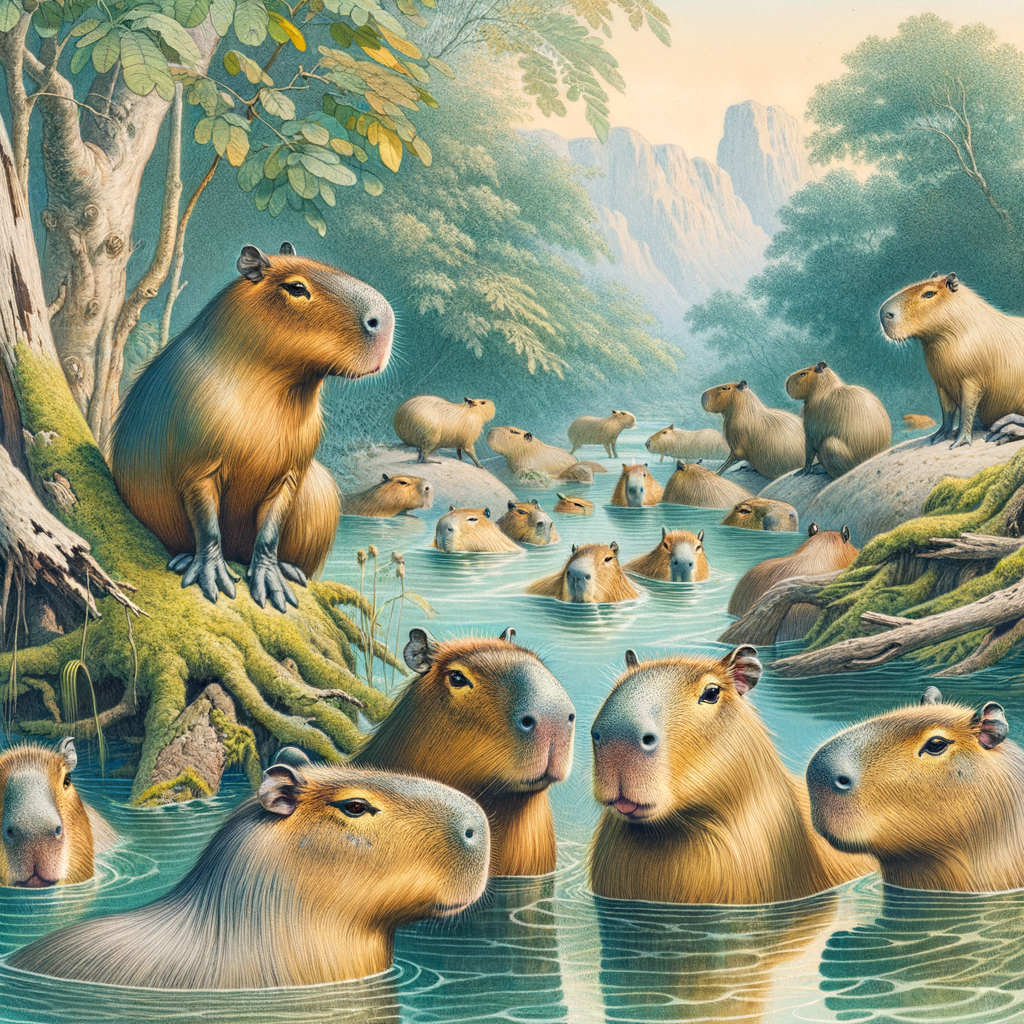
Introduction to Capybaras
Have you ever heard of a capybara? It’s not a type of fruit or a fancy car, but a fascinating creature that lives in South America. Let’s dive into the world of capybaras and learn more about them and their habitat.
-
- Overview of Capybaras
The capybara is the largest rodent in the world. That’s right, it’s a rodent, just like a mouse or a squirrel, but much bigger. Imagine a guinea pig, but the size of a medium-sized dog. That’s a capybara! They can weigh up to 145 pounds and grow up to 4.3 feet long. Capybaras have a barrel-shaped body covered in brown fur, short legs, and a small head with tiny ears and eyes. They are excellent swimmers and spend a lot of their time in the water.
-
- Understanding their Habitat
Capybaras live in groups of 10 to 20 individuals in the wetland areas of South America. They are found in countries like Brazil, Argentina, and Venezuela. Their perfect home is near bodies of water such as rivers, lakes, swamps, and marshes. This is because capybaras love to swim and they eat water plants and grasses. They also use water as a hiding place from predators like jaguars and anacondas.
So, the next time you hear the word ‘capybara’, you’ll know exactly what it is. A large, friendly rodent that loves to swim and lives in South America. Isn’t that interesting? In the next sections, we will explore more about the capybara’s habitat and their role in the ecosystem.
Capybara Habitat and Water Quality
Understanding the habitat of the capybara and its relationship with water quality is crucial. Capybaras, the world’s largest rodents, play an essential role in maintaining the health of their habitats, particularly in terms of water quality. Let’s delve deeper into this topic.
Role of Capybara in Water Quality Conservation
Capybaras have a significant impact on water quality in their habitats. They contribute to water quality in several ways, and their presence can have a profound effect on the water bodies they inhabit.
-
- How Capybaras contribute to water quality
Capybaras are semi-aquatic animals, spending a lot of their time in and around water. They eat a variety of plants, including water plants, and their feeding habits help control the growth of these plants. By doing so, they prevent the overgrowth of certain plant species that could otherwise deplete oxygen levels in the water and harm other aquatic life.
-
- Impact of Capybara on water
Aside from their feeding habits, capybaras also contribute to water quality through their waste. Their droppings serve as a natural fertilizer, enriching the water with nutrients that promote the growth of beneficial algae and other aquatic plants. These plants, in turn, help maintain the water’s oxygen levels, supporting a healthy ecosystem.
In conclusion, capybaras play a vital role in maintaining water quality in their habitats. Their presence and activities contribute to a balanced and healthy ecosystem, making them an important part of the natural world.
Water Quality and Wildlife
Water quality is a critical factor that impacts the health and survival of wildlife, including the capybara. Let’s explore the importance of water quality for wildlife and the role that wildlife, like the capybara, play in maintaining water quality.
- Importance of Water Quality for Wildlife
Water is the lifeblood of our planet, and its quality directly affects all forms of life, including wildlife. Clean water is essential for wildlife to drink, bathe, and live in. It also plays a crucial role in their food chain.
For instance, capybaras, the world’s largest rodents, are semi-aquatic animals that spend a lot of their time in and around water. They depend on clean water for their survival. Poor water quality can lead to diseases and can disrupt their natural behavior, affecting their overall health and survival.
According to a study, when water quality declines, it can lead to a decrease in wildlife populations. This is because poor water quality can affect the availability and quality of food sources, disrupt reproductive cycles, and increase vulnerability to diseases.
- Role of Wildlife in Maintaining Water Quality
Wildlife also plays a significant role in maintaining water quality. They contribute to the balance of the ecosystem, which is essential for preserving water quality.
Take the capybara, for example. Capybaras are known as “ecosystem engineers” because of their role in shaping and maintaining their habitats. They eat aquatic vegetation, which helps control the growth of these plants and prevent them from choking water bodies. This contributes to maintaining the water quality in their habitat.
Moreover, their droppings serve as a source of nutrients for the water bodies, promoting the growth of beneficial algae and other microorganisms that help purify the water. Thus, wildlife, like capybaras, play a crucial role in maintaining water quality.
In conclusion, water quality and wildlife are interconnected. The health of our wildlife is a reflection of the quality of our water. Therefore, it is essential to ensure the quality of water to protect our wildlife and maintain the balance of our ecosystems.
Capybaras: The Water Guardians
As we delve into the world of capybaras, we find that these creatures are not just the largest rodents in the world, but also vital guardians of our water bodies. Let’s explore how capybaras play a significant role in preserving aquatic life and the impact they have on aquatic ecosystems.
Understanding the Capybara’s Role in Aquatic Life Preservation
Often referred to as the ‘water pig’, the capybara thrives in water-rich environments. But did you know that they also play a crucial role in preserving these aquatic habitats? Let’s find out how.
-
- How Capybaras help preserve aquatic life
Capybaras are known for their unique diet, which consists mainly of water plants. By consuming these plants, they help control their growth and prevent them from overpopulating the water bodies. This balance in vegetation allows other aquatic species to thrive, contributing to a healthy and diverse ecosystem.
-
- Examples of Capybara’s impact on aquatic ecosystems
One prime example of the capybara’s impact is seen in the Pantanal wetlands of South America. Here, capybaras graze on water hyacinths, a plant known for its rapid growth. By keeping the population of these plants in check, capybaras help maintain the water’s oxygen levels, benefiting all aquatic life in the area.
In conclusion, the capybara’s role as a water guardian is vital for the preservation of aquatic life. Their dietary habits help maintain a balance in the ecosystem, allowing for a diverse range of species to coexist. So, the next time you spot a capybara, remember, they are not just cute creatures, but also crucial protectors of our water bodies.
Capybara and Environmental Health
When we talk about environmental health, we often focus on human activities and their impacts. However, animals, especially those like the Capybara, play a significant role in maintaining and enhancing environmental health. Let’s delve into the impact of Capybaras on environmental health and some case studies that highlight their positive influence.
-
- Impact of Capybaras on Environmental Health
Capybaras, often referred to as the ‘Water Guardians’, contribute significantly to environmental health. They are herbivores, feeding on grasses and aquatic plants. This diet helps control vegetation growth, maintaining a balanced ecosystem. Their droppings also serve as a natural fertilizer, enriching the soil and promoting plant growth.
Moreover, Capybaras are known to dig burrows, which can help prevent soil erosion and improve water infiltration, reducing the risk of floods. They also serve as a food source for predators, contributing to the food chain and biodiversity. In essence, the presence of Capybaras can indicate a healthy environment.
-
- Case Studies of Capybara’s Positive Impact on the Environment
Several studies have highlighted the positive impact of Capybaras on the environment. One such study conducted in the Pantanal wetlands of Brazil showed that areas with a high population of Capybaras had better soil quality and more diverse plant species compared to areas without them.
Another study in Venezuela’s Los Llanos region found that Capybaras helped maintain the health of the wetlands by controlling the growth of aquatic plants. Their burrowing activities also created habitats for other species, promoting biodiversity.
In Argentina, a project introduced Capybaras to a degraded wetland area. Over time, the presence of these animals improved soil quality and increased plant diversity, demonstrating their role in habitat restoration.
In conclusion, Capybaras, the ‘Water Guardians’, play a crucial role in maintaining and enhancing environmental health. Their activities contribute to soil enrichment, vegetation control, flood prevention, and biodiversity. These case studies highlight the importance of preserving and protecting these remarkable creatures and their habitats.
Impact of Capybaras on Ecosystem
Capybaras, often referred to as the “gentle giants” of the rodent world, play a significant role in maintaining the balance of their ecosystems. Their activities and behaviors contribute to the health and diversity of both terrestrial and aquatic habitats.
Role of Capybaras in Ecosystem Balance
Understanding the role of Capybaras in ecosystem balance involves looking at their behaviors and how these behaviors impact the environment around them.
-
- How Capybaras contribute to ecosystem balance
Capybaras are herbivores, feeding primarily on grasses and aquatic plants. This feeding behavior helps control plant growth and prevents overgrowth in their habitats. Additionally, their droppings serve as a natural fertilizer, enriching the soil and promoting plant growth.
-
- Examples of Capybara’s role in different ecosystems
In wetlands, Capybaras play a crucial role in shaping the landscape. Their grazing helps maintain the diversity of plant species, which in turn supports a variety of wildlife. In forests, their burrowing activities help aerate the soil, improving its quality and promoting the growth of diverse plant species.
Moreover, Capybaras are a key food source for many predators, including jaguars, pumas, and caimans. Their presence in an ecosystem can indicate a healthy predator population, which is essential for maintaining balance in the food chain.
In conclusion, Capybaras play a significant role in maintaining the balance and health of their ecosystems. Their feeding, burrowing, and role as prey all contribute to the diversity and vitality of their habitats.
Key Takeaways: Capybara and Ecosystem
-
- Understanding the importance of Capybaras in ecosystems
Capybaras, often referred to as the ‘Water Guardians’, play a vital role in maintaining the balance of ecosystems. They are herbivores, which means they eat a lot of vegetation. This helps to control the growth of plants and prevents overgrowth. Additionally, Capybaras are a food source for many predators, helping to keep their populations in check. They also contribute to the nutrient cycle by spreading seeds through their droppings, aiding in plant growth and diversity.
-
- Key points to remember about Capybaras and their role in the environment
| Key Points | Details |
|---|---|
| Herbivores | Capybaras eat a lot of vegetation, controlling plant growth and preventing overgrowth. |
| Food Source | They serve as a food source for many predators, helping to control their populations. |
| Nutrient Cycle | Capybaras contribute to the nutrient cycle by spreading seeds through their droppings, aiding in plant growth and diversity. |
Remember, Capybaras are not just cute animals, they are crucial for maintaining the balance of our ecosystems. They help regulate plant growth, serve as a food source for predators, and contribute to the nutrient cycle. So, next time you see a Capybara, remember the important role they play in our environment.
Conclusion: Capybaras and Water Quality
In this article, we have explored the fascinating world of capybaras and their significant role in maintaining water quality. Now, let’s summarize our findings and share some final thoughts on the importance of these creatures in water conservation.
-
- Summary of Capybara’s Role in Water Quality
Capybaras, often referred to as “water guardians,” play a crucial role in maintaining the water quality in their habitats. They do this by consuming aquatic vegetation, which helps control the growth of harmful algae. Moreover, their droppings serve as natural fertilizers, contributing to the overall health of the water ecosystem. This unique relationship between capybaras and water bodies is a testament to the intricate balance of nature.
-
- Final Thoughts on the Importance of Capybaras in Water Conservation
Water conservation is a pressing issue in today’s world, and every creature has a part to play. Capybaras, with their unique water-cleansing abilities, are no exception. Their role in maintaining water quality is a reminder of the interconnectedness of all life forms and the importance of preserving natural habitats. By protecting the capybara population, we are indirectly contributing to water conservation efforts.
In conclusion, capybaras are more than just the world’s largest rodents. They are vital contributors to their ecosystems, especially in terms of water quality and conservation. As we strive to protect our planet’s water resources, let’s remember the important role that even the smallest creatures play in this endeavor.
| Key Takeaways |
|---|
| Capybaras play a crucial role in maintaining water quality. |
| Their unique abilities contribute to water conservation efforts. |
| Protecting capybara habitats indirectly helps conserve water resources. |














